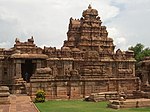Portal:India/Today's selected article/November 27, 2006
| This page is currently inactive and is retained for historical reference. Either the page is no longer relevant or consensus on its purpose has become unclear. To revive discussion, seek broader input via a forum such as the village pump. |
| This page is currently inactive and is retained for historical reference. Either the page is no longer relevant or consensus on its purpose has become unclear. To revive discussion, seek broader input via a forum such as the village pump. |
The Chalukya dynasty (Kannada: ಚಾಲುಕ್ಯರು, Kannada pronunciation: [tʃaːɭukjə]) was an Indian royal dynasty that ruled large parts of southern and central India between the 6th and the 12th centuries. During this period, they ruled as three closely related, but individual dynasties. The earliest dynasty is known as the Badami Chalukyas who ruled from their capital Badami from the middle of the 6th century. The Badami Chalukyas began to assert their independence at the decline of the Kadamba kingdom of Banavasi and rapidly rose to prominence during the reign of Pulakesi II. The other two later dynasties were the Eastern Chalukyas who ruled from Vengi and Western Chalukyas who ruled from Basavakalyan. The rise of the Chalukyas marks an important milestone in the history of South India and a golden age in the history of Karnataka. This period saw the birth of efficient administration, rise in overseas trade and commerce and the development of new style of architecture called Vesara. Around the 9th century, it also saw the growth of Kannada as a language of literature in the Jaina Puranas, Veerashaiva Vachanas and Brahminical traditions. The 11th century saw the birth of Telugu literature under the patronage of the Eastern Chalukyas. (more...)
Recently appeared: Red rain in Kerala – Buddhist art – Indian Standard Time

